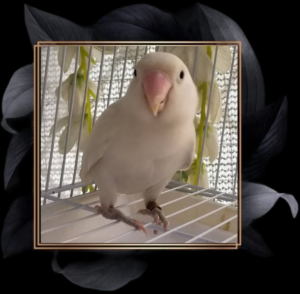dark eyed clear fischer lovebird
A mutation of one type in Fischer’s lovebirds, also known as “Dark-eyed Clear”. It leads to a bird with an odd pattern that is hard to miss. Here’s more information about the Dark-Eyed Clear Fischer’s Lovebird:

Appearance:
The Dark-Eyed Clear Fischer’s Lovebird exhibits distinct visual traits:
Plumage Color: Dark-eyed clear lovebirds are usually mostly white or cream colored. The coloration differs from the usual green feathering in wild-type lovebirds, that is Fischer’s. There is usually light pink or tan on the head and the body, with white or cream color as well.

Eye Color: Dark-eyed clear lovebirds remain with their black eyes that contrast starkly with their white or cream underparts. Thus, they are named having this spectacular feature.
Beak and Feet: The color of their usual horn beak and blue feet is retained in Lovebirds of Fischer’s type.
Inheritance:
Dark-eyed clear is caused by an autosomal, recessive mutation. Therefore, for Dark-Eyed Clear offspring, the parents should have one or more genes of the Dark-Eyed Clear allele. Dark-eyed clear chickens can be produced when two dark eyed lovebirds are interbred or another Fischer’s lovebird with dark-eyed clear genes is bred together.
Behavior and Care:
In terms of behavior and care, Dark-Eyed Clear Fischer’s Lovebirds have the same needs and characteristics as their wild-type counterparts:
Diet: The lovebirds should be fed on good quality pellets supplemented with chopped fresh greens, fruits and clean plain water.
Social Nature: The Lovebirds of Fischer include Dark Eyed Clear lovebirds which are very sociable birds. These lovebirds are very sociable, they love being together with each other as well as other lovebird. They should be kept as pairs or in small groups so that they can get company.
Enrichment: Lovebirds are indeed very energetic, funny and entertaining. They require a lot of mental stimulation, exercises, and lots of toys for dark-eyed clear lovebirds.
Cage and Environment: Make sure that the cage is appropriately sized for them, with perches, toys and other places they can explore.
Lifespan:
Proper care of Fischer’s “Lovebirds” ranges between ten and fifteen plus years (or more).
Avian enthusiast lovebird mutation Dark-eyed clear Fischer’s lovebirds are highly treasured due to their aesthetic beauty. In case of handling or caring for a Dark-Eyed Clear Lovebirds, one will need to understand its genetics and provide an adequate diet, socialization, and care. Working on specific color mutations often requires consulting experienced avian breeders or lovebird experts.